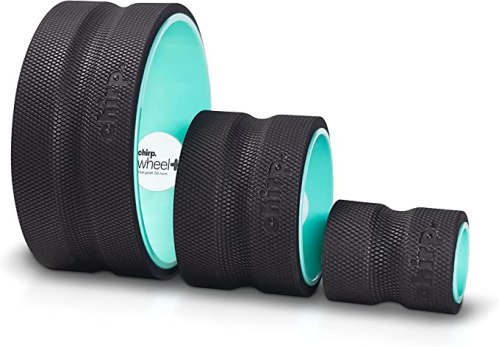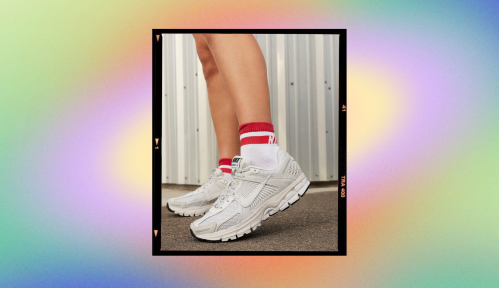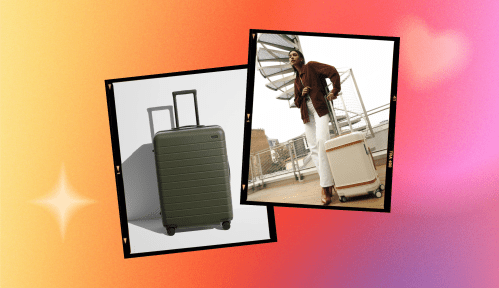Our editors independently select these products. Making a purchase through our links may earn Well+Good a commission
I have reached the point of WFH life that I am willing to do just about anything to fix my effed up posture. Fifteen minutes of daily upper-body stretches? Check. An adult-sized harness? Sure! A device that beeps every time I slump over? Why not. But when I came across The Chirp Wheel—a back massage device that’s earned more than 12,000 five-star reviews on Amazon—I had to ask the experts if I needed to invest in yet another tool to help perk up my posture, so I asked him for his own Chirp Wheel review.
Experts in This Article
chiropractor and founder of USA Sports Therapy
New York-based physical therapist at Hudson Premier Physical Therapy
What is the Chirp Wheel?
Chirp was brought to my attention during a Shark Tank rerun (FWIW: The founders got a deal), and the ring-shaped tool is designed to give you a deep, targeted stretch all the way down your back. Because it has less surface area than a foam roller, it allows you to really press into muscle knots.
“Spine roller wheels like the Chirp Wheel are designed to relieve tension and tightness in the back, neck, and shoulder muscles,” says physical therapist Sandra Gail Frayna, the founder of Hudson Premier Physical Therapy & Sports. “They use a combination of targeted pressure and stretching to help release knots and reduce pain.”

The Chirp Wheel 3-Pack — $100.00
This Chirp Wheel 3-pack contains three different sizes of back rollers to help relieve tension (in larger sizes) or act as more of a deep tissue massage (in smaller sizes). Individual large, medium, and small sizes are also available.
What is the Chirp Wheel good for?
People who have back tension and tightness may find the Chirp Wheel helpful if they want to ease back pain. According to Matthew Cooper, DC, CCSP, a chiropractor and the founder and CEO of USA Sports Therapy, it really does live up to the hype.
“For people experiencing muscle spasms, this device can help relax muscles in the spine,” he says. “It places your lumbar spine in extension, which could be excellent for people who suffer from herniated discs in their low back.”
Who should use a Chirp Wheel?
If you have back pain from workouts or just general tightness, you might want to give the wheel a roll. But if you
“Using a spine roller wheel like the Chirp Wheel can help anyone who suffers from back pain or tension,” Frayna says. “However, people with chronic back issues or injuries should consult with a medical professional before using any kind of back pain relief tool.”
Cooper suggests exercising caution (or avoiding the device altogether) if you’ve ever been diagnosed with spinal stenosis or facet joint problems, because the extension that the Chirp Wheel brings about in your upper body can cause more pain. And as a general rule: “If it hurts, I would suggest discontinuing use,” says Dr. Cooper. “But if it doesn’t hurt, it’s relatively safe.”
What to know about the Chirp Wheel
The wheel has a “rigid core” made of plastic, and is wrapped in a cushy foam on the outside. According to the Chirp Wheel website, this combination and circular form “puts pressure on the muscles surrounding the spine. In doing so, the muscles are stretched and strengthened.” It comes in three different sizes, each of which can be used to relieve different levels of tension.
The wheel fits snugly between your shoulder blades and is easy to roll down your spine to deliver a strain-reducing massage. It works to loosen up any knots that may have formed during difficult workouts or hours spent hunched over your desk, delivering all-over relief. What’s more, the wheel helps to restore the natural curvature of your spine, resulting in better posture, balance, and flexibility.
What’s the difference between the Chirp Wheel sizes?
The large wheel, which clocks in at 12 inches, is the gentlest option. The medium wheel, 10-inch wheel delivers more pressure. The small wheel, which at 6 inches is best for deep-tissue massage. You can also scoop up a bundle that includes all three ($99).
What’s the difference between roller wheels and foam rollers?
While you can help relieve tension in your back by lying on a foam roller, a chirp wheel may be a more targeted approach.
“Both roller wheels and foam rollers can be used to ease pain and tension in the muscles, however roller wheels are usually more precise and allow deeper pressure than foam rollers,” Frayna says.
But the upside of foam rollers is that they might be more versatile, since “they can be used for a wider range of exercises and stretches,” says Frayna. While a roller wheel like the Chirp Wheel will move up and down your spine, just laying directly on a foam roller from your head to your bottom will help release your spine. From there, you can enhance the relief by taking deep breaths, and doing different arm moves, like arm circles or cactuses.
When to use a Chirp Wheel—and when to call the doctor
It’s tempting to seek back pain relief from tools like the Chirp Wheel. But if you’re experiencing pain that isn’t related to muscle tightness, it might be best to leave the pain relief to the professionals.
“If you’re experiencing back pain, it’s important to consult with a medical professional to determine the underlying cause and avoid the injury worsening,” Frayna says.
Whether it works for you might largely depend on both the cause and the severity of the back pain.
“Using a device like the Chirp Wheel may offer relief if the pain is minimal or caused by tight or sore muscles,” Frayna says. “However it’s recommended to consult a doctor/PT if the pain is severe, lingering, or coupled with other symptoms.”
How to use the Chirp wheel to correct your posture
To improve posture, it might be tempting to get right on the Chirp Wheel and roll around on the floor, but Dr. Cooper advises new Chirp Wheelers who want to work on poor posture habits to ease into it.
“The best way to integrate this device into your wellness or stretching routine would be to start on your feet, placing the device behind your back and against the wall,” says Dr. Cooper. “From there, progress to the floor, rolling the device along your back.”
However, posture is not all about stretching. It’s necessary to build strength in your core and back, as well as lengthen the muscles of your chest, if you want to be able to maintain an upright position. The Chirp Wheel claims that it helps build muscle (including core strength), but you might want to integrate some posture-promoting moves into your regular workout routine as well. Those include the dead bug, bird dog, cat cow, and more.
Are Chirp Wheels worth the money?
While many reviewers swear by the Chirp Wheel, whether you want to shell out is up to you.
“Many people claim the Chirp Wheel is effective in relieving back pain and tension and improving spinal mobility,” Frayna says. “However, its results will vary on the individual’s specific condition and needs.”
You may want to try out some free ways to relieve back pain, such as stretching and mobility exercises, before you decide to invest in a new tool.
“While foam rolling can be beneficial, there are stretches and exercises that can achieve similar results,” Frayna says. “Whether it’s worth the money ultimately depends on the individual’s budget and priorities.”
Moreover, you might want to talk to your doctor before you take the plunge. “It’s always best to consult with a healthcare professional before starting any new treatment or exercise regimen,” Frayna says.
Want to stretch your back without a fancy tool? Follow along with the series below:
Sign Up for Our Daily Newsletter
Get all the latest in wellness, trends, food, fitness, beauty, and more delivered right to your inbox.
Got it, you've been added to our email list.








